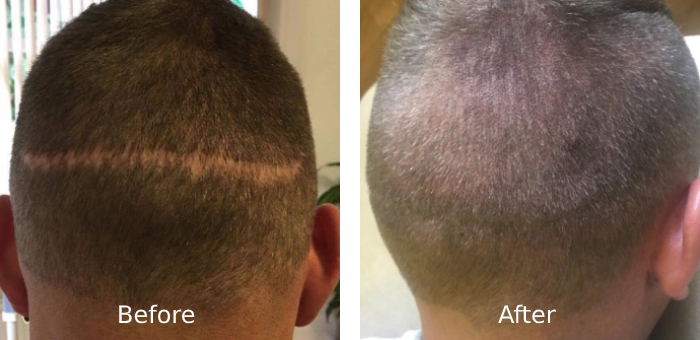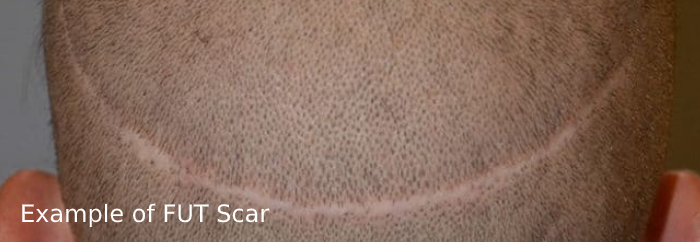The type of scarring depends on the type of transplant carried out. For either type, (FUT or
FUE), our SMP scar camouflage can be used to conceal any unsightly areas by the careful
placing of impressions amongst the scar tissue to remove the contrast between skin and hair.

FUT transplant
This involves removing a rectangular strip from the back of the head and dissecting it into grafts.
The section at the back is then stitched together, leaving what is known as a ‘strip scar.’ These
scars usually range from around five to twenty centimetres in length, and five to fifteen
millimeters in width.

FUE transplant
This more modern method involves removing single follicles at a time from the rear and sides of
the head. A good way to visualise this is to imagine a miniature version of an apple-corer! The
small tool punches into the skin, cuts out the follicle and retrieves it. The skin heals leaving a
small circular scar a few millimetres in diameter.

Sometimes both techniques are adopted in order to maximise the graft yield. Scar micropigmentation is effective for scars of either transplant type.
Despite the availability and low costs of transplants, scalp micropigmentation is increasing in
popularity. Using SMP for scar camouflage can be so effective that transplant scarring is not
really much of a concern anymore.
A hair transplant can be an excellent solution for some people, yielding fantastic results. As they
grow in popularity however and awareness is increased, we are becoming equally aware of their
drawbacks too. There are many success criteria involved, and all of which must be met in order
to achieve a full head of hair from a transplant. I’ll list them below.
Degree of Hair Loss
For someone in the early stages of hair loss, ie receding at the front with nothing more than very
minor thinning elsewhere, a hair transplant may prove successful due to not requiring many
grafts to address the issue and recreate the hairline and fullness. In this instance, for example,
1500 grafts may suffice and give the client a pretty much full head of hair. For a client whose
hair loss is more severe, let’s imagine number seven on the Norwood scale, those 1500 grafts would be a drop in the ocean and would not result in anything more than very thin and sparse
coverage across the scalp.
Donor Area
“Just use more grafts then!” Well, unless blessed with an unusually excellent donor area, the
client will be limited. It is very rare for those who are past the point of moderate hair loss to be
able to achieve a satisfying result or the look of fullness. There is a limit to the amount of hair
available in the donor area.
Surgeon’s Skillset and Experience
The surgeon’s expertise plays a huge role in determining the success of a hair transplant. The
surgeon will need to strategically place each follicle in the correct location and at the right angle
to ensure hair grows at a natural direction, and the fullest possible result is achieved.
Some grafts fail, but generally speaking the more experienced and skilled your surgeon is, the
higher the percentage rate of successful growth for your grafts.
Medication
For the most part, Finasteride (brand name Propecia) is recommended to clients in conjunction
with a transplant.
Finasteride is a drug which blocks the conversion of testosterone to dihydrotestosterone (or
DHT).
DHT is responsible for male pattern baldness, so taking this drug does effectively halt hair loss if
male pattern baldness is your issue, however it comes with an array of horrendous possible side
effects. Some users experience no side effects, some experience mild and temporary issues,
but many unfortunately get hit by detrimental, life changing and permanent side effects. There’s
only one way to discover if you are predisposed to these issues, and that’s by rolling the dice
and taking the medication! Trying this myself several years ago is one of my biggest life regrets
to this day.
If you opt not to take this medication then you must accept that most of whatever natural hair
you have remaining that the transplanted hair is added to will eventually fall out as you continue
your hair loss journey.
Summary
The science, research and sheer skill involved in the hair transplant industry is phenomenal.
There are some extremely talented surgeons and technicians all over the world and the work
they carry out is mind blowing.
You should be lucky enough to achieve a fantastic result if you meet all of the following criteria:
- You are in the early stages of hair loss and have some good coverage and density
remaining
- You have what would be considered a good donor area
- You research and find one of the top hair transplant surgeons in your area/country
- You are willing and able (and crazy enough!) to take Finasteride long term without
suffering side effects
We must face the reality though that a hair transplant, for many, cannot provide a full head of
hair or anything close. As they have grown in popularity and become mainstream, we see that
the amount dissatisfied customers largely outweighs the satisfied.
More and more people now opt for scalp micropigmentation instead due to the guaranteed
density achieved, freedom of hairline design & fullness, and lack of downtime/pain/scarring
involved.
If your interested in our scar micropigmentation why not contact us today!





